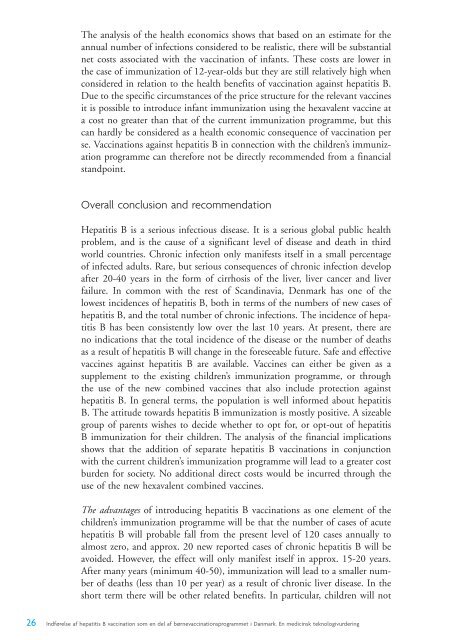Elektronisk udgave - Sundhedsstyrelsen
Elektronisk udgave - Sundhedsstyrelsen
Elektronisk udgave - Sundhedsstyrelsen
Create successful ePaper yourself
Turn your PDF publications into a flip-book with our unique Google optimized e-Paper software.
The analysis of the health economics shows that based on an estimate for the<br />
annual number of infections considered to be realistic, there will be substantial<br />
net costs associated with the vaccination of infants. These costs are lower in<br />
the case of immunization of 12-year-olds but they are still relatively high when<br />
considered in relation to the health benefits of vaccination against hepatitis B.<br />
Due to the specific circumstances of the price structure for the relevant vaccines<br />
it is possible to introduce infant immunization using the hexavalent vaccine at<br />
a cost no greater than that of the current immunization programme, but this<br />
can hardly be considered as a health economic consequence of vaccination per<br />
se. Vaccinations against hepatitis B in connection with the children’s immunization<br />
programme can therefore not be directly recommended from a financial<br />
standpoint.<br />
Overall conclusion and recommendation<br />
Hepatitis B is a serious infectious disease. It is a serious global public health<br />
problem, and is the cause of a significant level of disease and death in third<br />
world countries. Chronic infection only manifests itself in a small percentage<br />
of infected adults. Rare, but serious consequences of chronic infection develop<br />
after 20-40 years in the form of cirrhosis of the liver, liver cancer and liver<br />
failure. In common with the rest of Scandinavia, Denmark has one of the<br />
lowest incidences of hepatitis B, both in terms of the numbers of new cases of<br />
hepatitis B, and the total number of chronic infections. The incidence of hepatitis<br />
B has been consistently low over the last 10 years. At present, there are<br />
no indications that the total incidence of the disease or the number of deaths<br />
as a result of hepatitis B will change in the foreseeable future. Safe and effective<br />
vaccines against hepatitis B are available. Vaccines can either be given as a<br />
supplement to the existing children’s immunization programme, or through<br />
the use of the new combined vaccines that also include protection against<br />
hepatitis B. In general terms, the population is well informed about hepatitis<br />
B. The attitude towards hepatitis B immunization is mostly positive. A sizeable<br />
group of parents wishes to decide whether to opt for, or opt-out of hepatitis<br />
B immunization for their children. The analysis of the financial implications<br />
shows that the addition of separate hepatitis B vaccinations in conjunction<br />
with the current children’s immunization programme will lead to a greater cost<br />
burden for society. No additional direct costs would be incurred through the<br />
use of the new hexavalent combined vaccines.<br />
The advantages of introducing hepatitis B vaccinations as one element of the<br />
children’s immunization programme will be that the number of cases of acute<br />
hepatitis B will probable fall from the present level of 120 cases annually to<br />
almost zero, and approx. 20 new reported cases of chronic hepatitis B will be<br />
avoided. However, the effect will only manifest itself in approx. 15-20 years.<br />
After many years (minimum 40-50), immunization will lead to a smaller number<br />
of deaths (less than 10 per year) as a result of chronic liver disease. In the<br />
short term there will be other related benefits. In particular, children will not<br />
26 Indførelse af hepatitis B vaccination som en del af børnevaccinationsprogrammet i Danmark. En medicinsk teknologivurdering

















